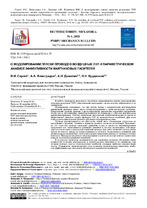| dc.contributor.author | Сергей, И. И. | |
| dc.contributor.author | Виноградов, А. А. | |
| dc.contributor.author | Данилин, А. Н. | |
| dc.contributor.author | Курдюмов, Н. Н. | |
| dc.coverage.spatial | Пермь | ru |
| dc.date.accessioned | 2024-03-19T11:12:48Z | |
| dc.date.available | 2024-03-19T11:12:48Z | |
| dc.date.issued | 2018 | |
| dc.identifier.citation | О моделировании пляски проводов воздушных ЛЭП и параметрическом анализе эффективности маятниковых гасителей = On modeling of overhead tlc galloping and parametric analysis of pendulum dampers efficiency / И. И. Сергей [и др.] // Вестник Пермского национального исследовательского политехнического университета. Механика. – 2018. – № 4. – С. 256-265. | ru |
| dc.identifier.uri | https://rep.bntu.by/handle/data/141488 | |
| dc.description.abstract | В работе приводятся результаты численного моделирования пляски (галопирования) проводов воздушных ЛЭП с маятниковыми гасителями с целью анализа эффективности их применения. Исследования показывают, что при пляске наряду с выраженными вертикальными движениями проводов имеют место синхронизированные с ними крутильные колебания. Закручивание провода приводит к дополнительному увеличению подъемных аэродинамических сил и, как следствие, амплитуд колебаний по сравнению с «чистым» вертикальным движением проводов. Поэтому управление крутильными колебаниями является одним из эффективных способов защиты проводов ЛЭП от низкочастотных колебаний. Для этого используются маятниковые гасители различных конструктивных схем. Провода рассматриваются как абсолютно гибкие нити, обладающие упругостью на растяжение и кручение. Тяжение в пределах пролёта считается постоянным. Принимается, что точки оси провода совершают движение только в плоскости, перпендикулярной продольной оси. Записываются уравнения динамики в частных производных, описывающих поступательные и крутильные колебания провода. Для учёта гасителей провод разбивается на участки, между которыми помещаются гасители. Записываются уравнения движения сосредоточенных масс гасителей под действием приложенных от проводов силовых факторов. Процедура численного интегрирования строится на основе конечно-разностного аналога полученных уравнений колебаний. В результате численных экспериментов для одиночных проводов обоснована схема совместной установки вертикальных и горизонтальных маятников и их параметры, при которых успешно гасятся низкочастотные колебания проводов наиболее опасных форм пляски. Определены первоначальные углы установки горизонтальных маятников, наиболее эффективных для расстройки крутильных и поперечных колебаний. | ru |
| dc.language.iso | ru | ru |
| dc.publisher | Пермский национальный исследовательский политехнический университет | ru |
| dc.title | О моделировании пляски проводов воздушных ЛЭП и параметрическом анализе эффективности маятниковых гасителей | ru |
| dc.title.alternative | On modeling of overhead tlc galloping and parametric analysis of pendulum dampers efficiency | ru |
| dc.type | Article | ru |
| local.description.annotation | The paper presents the results of a numerical simulation of the galloping of overhead transmission lines conductors (TLC) with pendulum dampers in order to analyze the efficiency of their application. Studies show that during galloping, along with the pronounced vertical movements of the conductors, there are synchronized torsional vibrations associated with them. Twisting of the conductors leads to an additional increase in the lifting aerodynamic forces and, as a result, the amplitudes of the vibrations in comparison with the "clean" vertical movement of the conductors. Therefore, the control of torsional vibrations is one of the effective ways to protect the transmission lines conductors from low-frequency oscillations. For this purpose, pendulum dampers of various structural schemes are used. Wires are considered as absolutely flexible threads, which have elasticity for tension and torsion. The tension within the span is considered constant. It is assumed that the points of the conductor axis move only in a plane that is perpendicular to the longitudinal axis. The equations of dynamics in partial derivatives describing translational and torsional vibrations of a wire are written. To account for the dampers, the conductor is divided into sections between which the dampers are placed. The equations of dampers motion under the action of the conductors are written. The numerical integration procedure is based on the finite-difference analogue of the obtained oscillation equations. As a result of the numerical experiments for single conductors, the scheme is justified for the joint installation of vertical and horizontal pendulums and their parameters, under which low frequency oscillations of conductors of the most dangerous forms of galloping are successfully damped. The initial installation angles are determined for horizontal pendulums which are most effective for detuning torsional and transverse oscillations. | ru |

